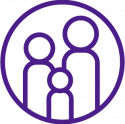
Southern California Psychotherapy
Psychotherapy is a first-line treatment for improving mental health at Southern California Sunrise Recovery Center in Mission Viejo. The dialogue that takes place in psychotherapy can help one overcome problematic thoughts or behaviors, increasing one’s well-being and healing. It is an integral component of our Orange County Mental Health Services.
What Is Psychotherapy?
Psychotherapy, commonly known as talk therapy, is a proven and effective type of mental health treatment. It is the use of psychological techniques based on personal interactions — such as talking — to prevent and change problematic thinking, behaviors, and emotions.
Psychotherapy provides help to individuals struggling with the various emotional thoughts, feelings, and behaviors produced by their mental health conditions. Because it can help many people understand the roots of their mental illnesses, it has become a popular and often recommended treatment.
There are a various different approaches to psychotherapy. Some are more specific to certain conditions, leveraging different methods to tackle different disorders.
When mental health professionals properly provide psychotherapy to treat mental illnesses, patients typically experience significant decreases in their side-effect intensities. With mental health care therapy sessions strengthening one’s control over their symptoms, the patient can begin functioning better, increasing the body and mind’s overall health and well-being.
Common Types of Psychotherapy
Depending on the specifics of each patient’s mental health state, there are a couple of different techniques used by doctors and therapists when approaching each situation. This process is meant to help determine the form of therapy and if any extra precautions need to be taken upon beginning treatment. After a brief conversation concerning the details of the disorder, the therapist will then make their decision as to what approach to use.
A few standard treatment approaches for psychotherapy include:
Interpersonal Therapy
This form of therapy focuses more specifically on the various interactions and behaviors that are exhibited around close friends and family. Typically lasting sometime between 3 and 4 months, the primary objective during interpersonal therapy sessions is to improve or strengthen the patient’s self-esteem and communication skills.
This treatment is most commonly used to treat depression and anxiety disorders that may have developed from any of the following:
- Social isolation
- Significant life event
- Relationship complications
- Trouble dealing with grief and loss
- Becoming a new parent
Cognitive-Behavioral Therapy
Cognitive-behavioral therapy, or (CBT), is designed to help mental health patients to recognize and directly identify underwhelming perceptions about themselves so that the appropriate corrections can be made. It is the therapist’s job to help establish new and improved methods of thinking by emphasizing both the “wrong” and “right” assumptions that may be being made about themselves and others.
This form of psychotherapy treatment is recommended for individuals who:
- Anyone who struggles with an anxiety disorder or moderate to severe depression
- Those who suffer from a mental health illness that causes personal life issues or other disabilities
- Anyone who expresses behaviors or thoughts that trigger or worsen the state of their mental health
- People who are physically unable or flat-out refuse to take certain medications such as an antidepressant
Psychodynamic Therapy
Psychodynamic therapy is conducted based on the assumption that emotional problems are being experienced because of traumatic or unresolved conflicts that possibly began during childhood. Psychodynamic therapy is meant to help patients understand and better manage these harsh feelings while sharing these experiences with their therapist.
This form of treatment usually takes place over a period of at least several months, with the more severe cases capable of lasting much longer.
Dialectical Behavior Therapy
Dialectical behavior therapy, or (DBT), is a type of cognitive-behavioral treatment typically only used for the more stringent and high-risk patients. This form of treatment is designed to help accurately identify and correct any unintentional behaviors that harm them and others.
Comprehensive dialectical behavioral therapy usually focuses on four primary ways meant to enhance the patient’s life skills:
- Interpersonal Effectiveness: Being able to navigate through various conflicting situations that are frequently encountered.
- Emotion Regulation: Being able to recognize and identify certain emotions so that they can be adjusted appropriately.
- Distress Tolerance: Practicing to the point of feeling intense emotions like fear or anger without automatically lashing out and acting impulsively. Also, learning to be strong enough to not turn to substance abuse in an attempt to lessen the feelings of distress.
- Mindfulness: Being able to become more aware of yourself as an individual continually. Also, being more attentive in the present time and taking advantage of those moments.
Psychotherapy Formats & Settings
The National Alliance on Mental Illness outlines that there are four primary formats used for psychotherapy treatment that encompass the vast majority of mental health conditions that most people suffer from, including eating disorders.
They are:
Individual (1:1)

This form of therapy involves more of a personal setting where the patient and therapist can be more open and intimate about the thoughts and feelings being affected by the mental illness. One-on-one dialogue can help one feel safe about expressing their true, deep emotions and thoughts — especially after a professional therapist establishes trust between them and the patient.
Family

It has been seen that the role of a patient’s family can be a great mood stabilizer. It is also one of the critical resources that can consistently improve the overall mental health condition. It is always extremely beneficial for close friends and especially family members to fully understand the mental illness and potential side effects.
Couples or Marriage

When psychotherapy sessions are conducted with the patient’s significant other or spouse present, it helps to create unity in the relationships by having a mutual understanding of every aspect of their mental health state. Attending therapy together also gives new skills and communication techniques to be learned that can help them maintain a healthy and robust relationship. This therapy method has also been seen to be beneficial in other struggling aspects of relationships.
Support Groups

In this specialized psychotherapy treatment setting, two or more participants would engage in the therapy sessions at the same time. This is done in the hopes of the patients being able to grow comfortable with each other and share personal experiences related to their mental health conditions. Learning that it is possible for other people to feel similar feelings and have similar thoughts can set a strong foundation for a better and more healthy future coping with specific mental illness.
Get Psychotherapy in California
Your mental illness doesn’t define you and it doesn’t have to control your life. The staff at Southern California Sunrise Recovery’s Mental Health Center in Mission Viejo has helped people with a diverse range of disorders, and they want to help you.
Life is inherently difficult, and going through it with a mental illness can make circumstances even more challenging. Do yourself and the one’s you love a favor by properly addressing your mental health and becoming the best version of yourself.
Our caring staff of psychologists, psychiatrists, and therapists will be able to guide you or your loved one through every concern.
Get help — Call today and our admission specialists will gladly discuss our process and answer any questions you may have.